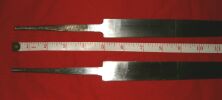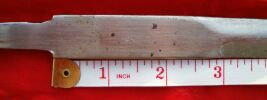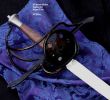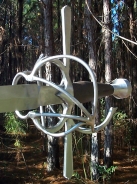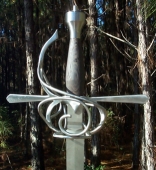Fencing
Projects
Pictures
· Steppes Warlord XXXII
· Elfsea Defender XXVI
· Bryn Gwlad's 25th
· AOS from KWAR 2004
· KWAR 2004
· Ansteorra's Argent Anniversary
Feedback Welcome: email sca at dwarfworks
Please read the
SCA
Approved Blade Types
to determine what blades you may use in your
kingdom.
Scroll down for pictures & technical details on the blades.

Rapier Blades Price Comparison
| Triplette |
Alchem, Inc. |
Darkwood Armory |
By The Sword |
James The Just | |||
| Rapiers | |||||||
| Triplette | |||||||
| 35" |
$65 |
$65 | |||||
| 40" |
$85 |
$85 | |||||
| Alchem Schlager/Rapier w/ flat tang
|
|||||||
| 30" to 42" |
$75 |
||||||
| Alchem Schlager/Rapier w/ rod
tang |
|||||||
| 27" to 40" |
$90 |
||||||
| Angus Trim |
|||||||
| up to 44" |
$230 |
||||||
| Del Tin Bated |
|||||||
| 42" |
$160 |
||||||
| Del Tin Practice |
|||||||
| 42" |
$160 |
||||||
| Darkwood Bated |
|||||||
| 37",39",42" |
$155 |
||||||
| 45" |
$170 |
||||||
| Darkwood Practice |
|||||||
| 37",39",42" |
$150 |
||||||
| 45" |
$165 |
||||||
| Hanwei Practical |
|||||||
| 37" |
$75 (#OH1061 37" Replacement Blade for SH1099 Fencing Rapier ) |
$65 | |||||
|
43" (A Hanwei Practical Rapier is usually the least expensive full rig available for the budget conscious, see details below)
|
$70 |
$80 (#OH1060 43" Replacement Blade for SH1098 Fencing Rapier ) |
$70 | ||||
Prices Checked April 24, 2005

| Terminology on this
page: Material - the variety of steel used in the making of this blade. Length - The length of the blade NOT including the tang. Tang length - The length of the tang. Ricasso length - The length of the non-edged, flat profiled portion of the sword beginning from the tang. Profile taper - The width of the blade measured at the beginning of the ricasso to the width of the blade measured at the tip of the blade immediately before any rounding of the tip. Distal taper - the thickness of the blade measured at the beginning of the ricasso to the thickness of the blade measured at the tip of the blade immediately before any rounding of the tip. Flex Min/Max - The force, measured in lbs. that it takes to flex the blade when stationary. First, with the palm flat on the pommel to get the minimum flex force, secondly with the hand wrapped around the tang attempting to keep the blade from flexing. (This test is the same test used by Alchem Inc.) Balance Point - the balance point of the blade. The balance point is determined then the measurement is taken from the beginning of the ricasso to that point NOT including the tang. Weight - this should be self explanatory Facts - additional facts that do not fit into the previous items. Opinions - opinions of various people about the blade(s) in question. Please feel free to send me your own opinions and they will be added without attribution (unless requested). NOTE: all measurements, etc. are taken off of naked blades. NOTE 2: Most of these blades (if not all) are hand forged and thus no two blades will ever be identical. Every statistic printed here is from a representative blade (or two)and must therefore be taken with the proverbial grain of salt. YiS Ceallach Mac Donal in the Barony of Bryn Gwlad in the Kingdom of Ansteorra MKA Kelly Hatcher Austin, Texas ceallach at dwarf works dot com |

Triplette Rapier

Zamarano

Alchem Flat Tang Schlager/Rapier
| Material: |
1074 high carbon steel |
| Length(s): |
30" to 42" |
| Tang Length: |
up to 7 1/2" |
| Tang Type: |
Flat |
| Ricasso Length: |
|
| Profile Taper: |
1 1/4" -> 3/8" |
| Distal Taper: |
|
| Flex Min/Max: | from 10/18 to 12/25 |
| Balance Point: |
|
| Weight: |
19 ounces or 540 grams
|
| Facts: Flat tang blades require a a custom pinned pommel. Blade has a button tip. Double taper design (I assume this to mean it has a distal taper) , rounded rather than flat (rebated) edge. All alchem blades come prepackaged with a bird blunt. According to James Koch of Alchem Inc, these rod and flat tang schlagers are the only Alchem blades approved by the SCA and he has no knowledge of anyone approving his SafeFlex colichemarde blade. | |
| Opinions: 1. The Alchem Inc. Schlager is one of, if not the best blade currently available to SCA and re-enactor groups out there. Haveing looked for years for certain specs in blades I finally stumbled across James Koch and his wonderful stuff. The Alchem blades are (as it says in his specs) are in a nutshell, rectangular. What this has acomplished is a blade that withstands SEVERE use and holds up EXTREMELY well. I used and abused mine for over a year before i had to even think about doing some basic maintenace. (a quick sanding job) It has altered my opinion on how schlagers are made and I personally will only buy Alchem, even over something as nefariouse as Dell Tin. A lot of my friends want to get some as well. But the largest thing as more or less the price tag on them. but we all know that it is worth every penny. Alchem has this wonderfull ability as well to make any length of blade (within reason) from his, what I have made famouse in my kingdom as the "toothpick" , 27" to his 40 inch and anything in between. My wife wants a 32, James goes "ok" He just did a damn good job with his toys. Currently, Artemisia has them on experimental pending the return of the Laural Marshal of the Societies return of documents. This will also include, from what I have been hearing, the "curved" schlager as well. So for all intents and purposes Alchem has been made legal in this kingdom. | |

Alchem Rod Tang Schlager/Rapier

Hanwei Practical Rapiers
| Material: |
1070 steel (high carbon alloy)
|
| Length(s): |
43" / 37" |
| Tang Length: |
~5" |
| Tang Type: |
Variable width tapering to
threaded 6x1 metric for the last 1 to 2 inches |
| Ricasso Length: |
~3 1/2" |
| Profile Taper: | 43" : 1 1/4" -> 3/8" 37" : 1 1/4" -> 3/8" |
| Distal Taper: |
43" : 3/16" -> 3/32" 37" : 3/16" -> 3/32" |
| Flex Min/Max: | 43" : 9 / 18 37" : 12 / 20 |
| Balance Point: |
43" : 32.4% or 13 7/8" 37" : 31.9% or 11 3/4" |
| Weight: |
43" : 15.9 ounces or 450
grams 37" : 13.6 ounces or 386 grams |
| Facts: Blade has a button tip. Rebated edge is flat and ~3mm The Hanwei Practical Rapier series swords and blades may also be seen as "Paul Chen", "CAS Iberia", or "C.A.S. Iberia" Practical Rapiers. This blade is the cheapest entry into the heavy fencing arena, and a complete rapier can usually be found for around $130. If not, James the Just is currently carrying the full CAS Iberia Practical Rapier for $140 | |
| Opinions: 1. The Hanwei / Paul Chen (C.A.S Iberia) blades may be of iffy long-term value. The first year or so of these blades had some quality issues, although James the Just informed me that he thinks that they have gotten over that problem. 2. These blades seem to have poor quality control. My 43" has been reasonably good, except for being very prone to picking up deep nicks on the edges. The blade is soft and whippy, but it's to be expected in a 43"to some extent. The 35/37" blades seem to be a very good value for the beginning fencer. The stiffness is usually good without being too hard. The issue is still the same with hit and miss tempering for overall hardness and durability of all blade lengths. Some non sca fencers have had success in re-tempering these blades, which alas is not legal in our world. 3. Excellent value for the money. The quality control and balance
continue to be iffy, the blades are a little overheavy, but overall the
blade comes in at 75% of a possible 100% | |

Darkwood Practice
| Material: |
5160 steel (chromium-molybdenum alloy) |
| Length(s): |
45" / 42" / 39" / 37" |
| Tang Length: |
|
| Tang Type: |
|
| Ricasso Length: |
2" |
| Profile Taper: |
3/4" -> |
| Distal Taper: |
|
| Flex Min/Max: | |
| Balance Point: |
|
| Weight: |
~13.8 ounces or 390 grams
|
| Facts: | |
| Opinions: | |

Darkwood Bated
| Material: |
5160 steel (chromium-molybdenum alloy) |
| Length(s): |
45" / 42" / 39" / 37" |
| Tang Length: |
|
| Tang Type: |
|
| Ricasso Length: |
2" |
| Profile Taper: | 7/8" -> |
| Distal Taper: |
|
| Flex Min/Max: | |
| Balance Point: |
|
| Weight: |
440 grams (~15.5 ounces) |
| Facts: | |
| Opinions:
| |

Del Tin Practice, Mark I
| Material: |
6150 steel (chrome-vanadium alloy) |
| Length(s): |
~42" |
| Tang Length: |
4 1/4" - 4 1/2" |
| Tang Type: |
Variable width, tapering to
~3/4" of ~15/64 threaded rod at 6x1 metric |
| Ricasso Length: |
4" |
| Profile Taper: |
3/4" -> 9/32" |
| Distal Taper: |
3/16" -> |
| Flex Min/Max: | 6.5 / ?? |
| Balance Point: |
34.2% or 14 3/8" |
| Weight: |
12.6 ounces or 358 grams
|
| Facts: This blade is no longer manufactured. | |
| Opinions: The original Del Tin blade for the SCA, this blade was thought to be too "floppy" by some and so the stiffer MK 2 was designed to replace it. However, it is less "floppy" than the current crop of Hanwei rapiers and it is light and quick. | |

Del Tin Practice, Mark II

Del Tin Bated

Angus Trim

Steel Alloys: Steel is an alloy of iron that must contain Carbon. it is the most important hardening elementOther elements may be added for specific applications. Carbon The most important element which increases the strength of the steel, and without a high enough percentage, alloy would not harden. High Carbon Steel contains minimum of .5% carbon, higher the %, higher hardness can be achieved Designation First numbers - 10 means plain carbon steel, any other number designate alloy steel. 50xx serie is a chromium steel. SAE designation system, steels with letter designations are tool steels - W-1, O-1, D-2 Designation Last numbers of a steel specify the steel's carbon content = 1095 has 0.95% carbon. 52100 has 1.0% carbon. 5160 has 0.60% carbon. Chromium - Gives the alloy it corrosion resistance, forms chromium carbides for wear resistance, and hardenability. Stainless Steel - is a steel with at least 13% chromium. The first 11% disolves and form carbides, left over are your rust resistance. Higher the %, more free chromium, more rust resistance. All stainless steel alloys can rust, they are only rust resistant, not rust proof. As with plain high carbon steels, proper blade maintenance is needed, though not as much. Manganese - Manganese helps the grain structure, and contributes to hardenability. Also strength & wear resistance. Improves the steel (e.g., deoxidizes) during the steel's manufacturing (hot working and rolling). Present in most cutlery steels except for A-2, L-6, and CPM 420V. Molybdenum - Forms carbides, prevents brittleness & maintains the steel's strength at high temperatures. It is added to many steel alloys, to enable them to harden in the air. A-2, ATS-34) always have 1% or more molybdenum Nickel - Enhancer for strength, corrosion resistance, and toughness. Present in L-6 and AUS-6 and AUS-8. Silicon - Increases strength, and wear resistance. Like manganese, it makes the steel more sound while it's being manufactured. Tungsten - Increases wear resistance. When combined properly with chromium or molybdenum, tungsten will make the steel to be a high-speed steel. The high-speed steel M-2 has a high amount of tungsten. Vanadium - Forms finely structured carbides to enhance wear resistance and hardenability. A number of steels have vanadium, but M-2, Vascowear, and CPM T440V and 420V (in order of increasing amounts) have high amounts of vanadium. BG-42's biggest difference with ATS-34 is the addition of vanadium. This information copied from: http://ajh-knives.com/metals.html |







